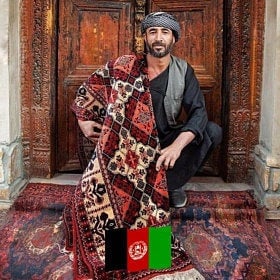- By Scott Peterson Staff writer@peterson__scott
KABUL, Afghanistan scene has barely changed for centuries: Afghan women sit at looms strung tight with twine, working slowly and meticulously to turn bundles of brightly colored wool thread into fine carpets.
What has changed is that this carpet weaving center, perched on the western edge of Kabul, is part of a broader project to help transform Afghanistan’s carpet industry. Among its goals: to break the isolation imposed by four decades of war and sell high-end, custom-made Afghan carpets directly to the international market.
Along the way, the British development organization Turquoise Mountain aims to herald a renaissance in Afghan carpet weaving. For years, Turquoise Mountain has specialized in urban reclamation, job creation, and training projects in Kabul, and in bringing Afghan jewelry, ceramics, and wood-working handicrafts to a global audience.
With 1.6 million Afghans in the carpet business, most of the weavers working from home, there is no shortage of carpet-making expertise. But during 40 years of conflict, some 90% of Afghan carpets were sent to neighboring Pakistan for eventual export. There the final touches – washing and “finishing” of carpets, including shearing them and binding the edges – were added, and Afghan carpets were often tagged with a “Made in Pakistan” label.
Working under a U.S. Agency for International Development contract, Turquoise Mountain aims to serve as a bridge for Afghan carpets to foreign buyers while bringing every step of the process back to Afghanistan. That will increase earnings for Afghans while also ensuring consistent quality and better working conditions.“Carpets have been produced in this region for millennia – not even hundreds of years, but thousands of years. And when people speak about Afghan rugs, it resonates. ... An ‘Afghan carpet’ is a thing,” says Nathalie Paarlberg, the Afghanistan deputy country director of Turquoise Mountain in Kabul. “But what you’ve seen is that we are now in our fourth decade of isolation,” she says. “The market has been entirely cut off from international buyers. … Why would you travel here if you could travel to India or Nepal, or even to Pakistan?”
Changing that equation for buyers is one aim of the project, along with creating 4,750 jobs and, over four years, selling $19 million worth of consistently high-quality Afghan carpets from the 15 producers they work with. The project also hopes in time to make the producers, who together represent several thousand Afghan families, and sales self-sufficient. Despite being out of the global market for a generation, Afghanistan still holds a grip on the imagination.“Speaking to these [carpet dealers], they look at an Afghan carpet and they get excited, they keep using the word ‘soul,’ to be honest,” says Nathan Stroupe, the Afghanistan country director for Turquoise Mountain. “There’s still that sort of magical quality in the carpets, and I think the mythos of the story.”
That story begins at looms like these in the western Kabul district of Dast-e Barchi, where the Zinnat Rug Factory produces some 700 square meters – about 7,500 square feet – of carpet each year, much of that as part of the Turquoise Mountain project. It has been established for 30 years, using 100 looms – most of them in family homes.
Women traditionally do the weaving work in Afghanistan, and in this well-lit weaving space, one or two sit in front of each loom, slowly adding to the carpets one thread at a time. Most weavers produce 1 square meter per month. Typical pay is $1 each day.
Next door in the showroom, men roll out onto the floor one carpet after another. Some have traditional Afghan designs, while others are more modern, such as a large replica of a Picasso painting, or stylized American flags. But this factory is a rarity in Afghanistan because work is done here that, for decades, had been done in Pakistan. They wash carpets, using hoses and brushes, and also finish them, using electric shears to cut and smooth the pile of each carpet. The average price per square meter of unfinished carpets is $50, and for finished carpets, $90 to $100.Weaving producers can easily employ 2,000 families each. But this project aims to expand the facilities of weaving centers like this one so that every step of production happens in one place. That way it is easier to monitor the quality of the work and working conditions, to earn ethical certification.
For example, at weaving centers in the northern highlands, not far from where the Taliban infamously destroyed towering Buddha statues in 2001, weavers must agree to send their children to school, ensuring they are not used for child labor. About 10 weaving centers working with Turquoise Mountain in a handful of cities, several already well established, will have daycare centers and provide one full meal a day for workers.
But there is another critical function that has been missing from most carpet-regeneration projects in Afghanistan since the U.S. military orchestrated the overthrow of the Taliban in 2001. Few such programs ever sought to also find a market for Afghan carpets abroad.“We have to be realistic here,” says Turquoise Mountain’s Ms. Paarlberg. Afghan manufacturers are “incredibly skilled at what they do,” but have not communicated with the international market for decades and usually don’t speak English.
“If you have to wait three weeks for a reply to your e-mail, or your bank transfer gets bounced back because your bank thinks you’re funding terrorism ... there’s just no reason why you would do business here,” she says.


